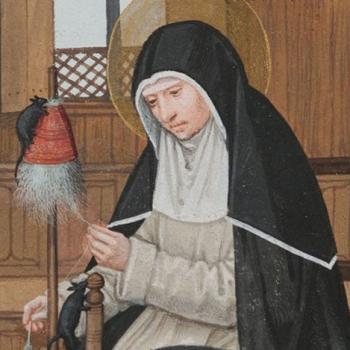A jealous husband brings his wife to the priests. There are no witnesses to the alleged adultery. The accused woman, the sotah, is a spectacle. She stands before her community, a Mincha temple sacrifice in her hands, her hair strewn about, uncovered by the priest as part of her punishment. As she stands in the public square, the eyes of her husband, her neighbors, and her children upon her. The priest tells her that if she is guilty, then she will be a cautionary tale of wantonness.
"May God render you as curse as an oath amid your people, when God causes your thigh to collapse and your stomach to distend. These Waters that cause curse shall enter your innards to cause stomach to distend and thigh collapse!"
The Sotah answers "Amen." (Num. 5:22-23)
She is forced to drink the "bitter waters"—water mixed with the ashes of her Mincha sacrifice. As the curse requires, if she is guilty she will die, her stomach will swell and explode. If she is innocent, her belly will swell with a child.
This remarkable ritual from Parsha Nasso and the magical jurisprudence it exemplifies exists in contrast to the normative Jewish tradition, where people judge, administer, and interpret the laws (Num. 5:11-31). If she is an adulterer she will explode; if she is a witch she will float. Judges—laity of exceptional character, not priests—are typically the administrators of justice in Tanakah (Ex. 18:17-23). However, the departure into magical jurisprudence in the case of adultery is common, even in the United States legal system, where changes in laws regarding adultery and illegitimacy have rendered the magical jurisprudence a hindrance to effectuating the reality of people's lives.
Only last week, while volunteering at a family law clinic, I met a man who could not put his name on his child's birth certificate, despite the mother's consent, because the mother was still legally married to another man. The Department of Health and Human Services would not accept the mother's and his word for it, and demanded a court order. In a case when the mother does not acknowledge that her lover and not her husband is the new child's father, even when her lover brings a DNA test to court, the court does not have to accept his undisputable scientific proof (Michael H. v. Gerald D.). When the judicial process turns away from the tangible and the verifiable, it necessarily turning towards the magical. When it comes to paternity, judicial decision making is a reaction to the quaint and outdated fear of declaring a child non-marital and the wishful thinking that all children born to married parents are the biological offspring of those parents.
The law, both religious and secular continues to assume whenever possible that children are of the marriage. In the Torah there are tragic legal consequences for children who are not born to the married couple. In Torah law or halakha, a special, detrimental status is conferred only on children of adulterous relationships versus children born to non-married parents. A child born to an adulterer mother from that adulterous relationship is a mamzer. The child cannot marry a Jew who is not a mamzer for ten generations. The sotah ritual publically legitimizes her pregnancy, saving her child from mamzer status. The pregnancy, which may be a tangible proof of her adultery, serves as the affirmation of her innocence. Her public humiliation becomes a publically witnessed affirmation and vindication that the child is of the marriage.
Exonerating the sotah and legitimizing her pregnancy is such a critical task that the Talmud dedicates an entire tractate to it. (There are only sixty-three tractates in all.) The Talmud adds two fundamental changes to the ritual: the opportunity to confess and an explanation of the third possibility, when the sotah does not die and does not conceive. To encourage confession, the sotah is taken to the Jerusalem Sanherdrin, the final judicial authority. If she confesses, then she is promptly divorced. No public humiliation and death required (Sotah 7a-b). If the sotah does not confess and instead undergoes the ritual, she may not die right away because she has personal merit (Sotah 6a). The Talmud's sotah can legitimize her child, save herself with prior good deeds, or force her husband into giving her a divorce, when traditionally only a man can free his wife from the bonds of marriage.
According to the Mishnah, the sotah ritual was abolished in the last two decades of the first temple period because of a presumed decline in the morality of the Jews (Mishnah 9:9). This fundamentally magically ritual provided a framework for protecting women and children against the draconian dictates of a moral system where ethics of sexuality are judged not by the level of consent but by the level of ownership.





